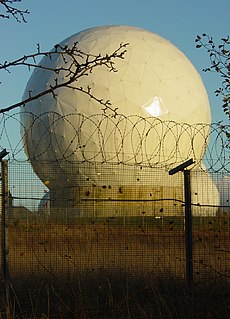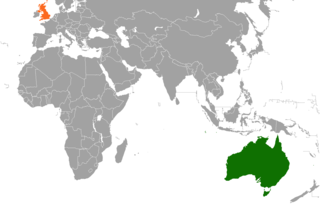Related Research Articles

ECHELON, originally a secret government code name, is a surveillance program operated by the United States with the aid of four other signatory states to the UKUSA Security Agreement: Australia, Canada, New Zealand, and the United Kingdom, also known as the Five Eyes.

The New Zealand Defence Force are the armed forces of New Zealand. The NZDF is responsible for the protection of the national security of New Zealand and her realm, promoting its interests, safeguarding peace and security, as well as supporting peacekeeping and humanitarian missions. It consists of three services: the Royal New Zealand Navy (RNZN), the New Zealand Army and the Royal New Zealand Air Force (RNZAF), and 'tri-service' components. The NZDF has a strength of 15,538 made up of 9,478 regular force personnel, 3,064 reserve force personnel and 2,996 civilian members. It is supported by the New Zealand Ministry of Defence (MOD) and is commanded by the Chief of Defence Force (CDF).

Australian Signals Directorate is the Australian government agency responsible for foreign signals intelligence, support to military operations, cyber warfare, and information security. ASD is part of the Australian Intelligence Community. ASD's role within UKUSA Agreement is to monitor SIGINT in South and East Asia. The ASD also houses the Australian Cyber Security Centre.

The Anglosphere is a group of English-speaking nations that share common ancestral, historical, or cultural ties with England or the United Kingdom broadly, and which today maintain close political, diplomatic and military co-operation. While the nations included in different sources vary, the Anglosphere is usually not considered to include all countries where English is an official language, so it is not synonymous with anglophone, though the nations that are commonly included were all once part of the British Empire.

The United Kingdom – United States of America Agreement is a multilateral agreement for cooperation in signals intelligence between Australia, Canada, New Zealand, the United Kingdom, and the United States. The alliance of intelligence operations is also known as the Five Eyes. In classification markings this is abbreviated as FVEY, with the individual countries being abbreviated as AUS, CAN, NZL, GBR, and USA, respectively.
The Defence Science and Technology Group (DSTG) is part of the Australian Department of Defence dedicated to providing science and technology support to safeguard Australia and its national interests. The agency's name was changed from Defence Science and Technology Organisation (DSTO) on 1 July 2015. It is Australia's second largest government-funded science organisation after the CSIRO and its research outcomes have enhanced Defence capability and supported operations for over 100 years.
The Defence Strategic Policy and Intelligence Group (SP&I) of the Australian Government Department of Defence is responsible for defence diplomacy, strategic policy, international security, and military intelligence co-ordination and advice to the Prime Minister of Australia, Minister for Defence, Secretary of the Department of Defence, and Chief of the Defence Force. The Defence Strategic Policy and Intelligence Group is led by the Deputy Secretary for Strategic Policy and Intelligence and comprises three policy divisions and two intelligence agencies.
The Combined Communications-Electronics Board (CCEB) is a five-nation joint military communications-electronics (C-E) organisation whose mission is the coordination of any military C-E matter that is referred to it by a member nation. The member nations of the CCEB are Australia, Canada, New Zealand, the United Kingdom and the United States. The CCEB is the Sponsoring Authority for all Allied Communications Publications (ACPs). ACPs are raised and issued under common agreement between the member nations. The CCEB Board consists of a senior Command, Control, Communications and Computer (C4) representative from each of the member nations.

The Five Eyes (FVEY) is an intelligence alliance comprising Australia, Canada, New Zealand, the United Kingdom, and the United States. These countries are parties to the multilateral UKUSA Agreement, a treaty for joint cooperation in signals intelligence.
The IDEAS Group is the International Defence Enterprise Architecture Specification for exchange Group. The deliverable of the project is a data exchange format for military Enterprise Architectures. The scope is four nation and covers MODAF (UK), DoDAF (USA), DNDAF (Canada) and the Australian Defence Architecture Framework (AUSDAF). The initial scope for exchange is the architectural data required to support coalition operations planning -

Command and control is a "set of organizational and technical attributes and processes ... [that] employs human, physical, and information resources to solve problems and accomplish missions" to achieve the goals of an organization or enterprise, according to a 2015 definition by military scientists Marius Vassiliou, David S. Alberts, and Jonathan R. Agre. The term often refers to a military system.

ABCANZ Armies is a program aimed at optimizing interoperability and standardization of training and equipment between the armies of Australia, Canada, New Zealand, the United Kingdom, and the United States, plus the United States Marine Corps and the Royal Marines. Established in 1947 as a means to capitalize on close cooperation between the United States, United Kingdom, and Canada during World War II, the program grew to include Australia and New Zealand.

Relations exist between the Commonwealth realms of Australia and the United Kingdom, marked by historical, cultural, institutional, extensive people-to-people links, aligned security interests, sporting tournaments, and significant trade and investment co-operation.
Signals intelligence by alliances, nations and industries comprises signals intelligence (SIGINT) gathering activities by national and non-national entities; these entities are commonly responsible for communications security (COMSEC) as well.

Canada–New Zealand relations refers to international relations between Canada and New Zealand. Canada and New Zealand have a longstanding relationship that has been fostered by both countries' shared history and culture, and links between residents of both countries. The two countries are former British Dominions and have a common head of state in Queen Elizabeth II. Both nations are members of the Asia-Pacific Economic Cooperation, Cairns Group, Commonwealth of Nations, Five Eyes, OECD and the United Nations.
John Riley is an Australian scientist at the Defence Science and Technology Organisation and former Australian rules footballer who played with Footscray in the Victorian Football League (VFL) and North Adelaide in the South Australian National Football League (SANFL).
AUSCANNZUKUS is an abbreviation for the naval Command, Control, Communications and Computers (C4) interoperability organization involving the Anglosphere nations of Australia, Canada, New Zealand, the United Kingdom, and the United States. It is also used as security caveat in the UKUSA Community, where it is also known as "Five Eyes."
The Air Force Interoperability Council or AFIC is an organisation tasked with enhancing coalition military aviation amongst the "Five Eyes" countries, which consist of Australia, Canada, New Zealand, the United Kingdom and United States. The organisation has a permanent management committee based in Washington DC.
References
- ↑ "TTCP website". Archived from the original on August 18, 2000.
- ↑ Multilateral Interoperability Programme website
- ↑ "ABCA website".
- ↑ ASIC websites: airstandards.org; dtic.mil
- ↑ AUSCANNZUKUS website Archived December 29, 2010, at the Wayback Machine
- ↑ "CCEB website". Archived from the original on 2009-08-25.